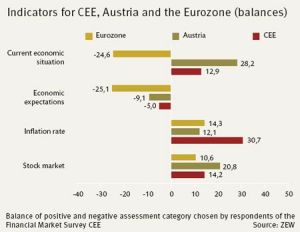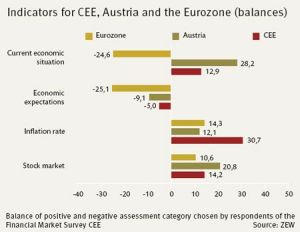 The major decrease of experts' optimism for the CEE region is likely to be a result of the increasing concerns regarding the Eurozone's economic prospects and reflects the increasing uncertainty on the financial markets. The economic sentiment indicator for the CEE region and further financial market data have been surveyed monthly by the Centre for European Economic Research (ZEW), Mannheim, with the support of Erste Group Bank, Vienna, since 2007.
The major decrease of experts' optimism for the CEE region is likely to be a result of the increasing concerns regarding the Eurozone's economic prospects and reflects the increasing uncertainty on the financial markets. The economic sentiment indicator for the CEE region and further financial market data have been surveyed monthly by the Centre for European Economic Research (ZEW), Mannheim, with the support of Erste Group Bank, Vienna, since 2007.Inflation expectations for the CEE region have dropped by 36.9 points reaching minus 6.2 points - the lowest level since September 2009.
The indicator which reflects the assessments of the current economic conditions in the CEE region has decreased by 10.1 points to 2.8 points in August. The evaluation of the current economic situation in the Eurozone has worsened by 14.6 points to the minus 39.2 mark.
Information concerning further indicators of the CEE region, the Eurozone, individually analysed CEE countries or Austria can be found here. The answers of all survey participants are taken into account for the calculation of the indicators for the CEE region, the Eurozone and Turkey. The answers of the Turkish survey participants are not taken into account for the calculation of the indicators for the individual CEE countries.
2838 views


